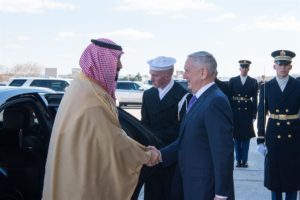By Robert Parry
Global Research, April 14, 2017
After making the provocative and dangerous charge that Russia is covering up Syria's use of chemical weapons, the Trump administration withheld key evidence to support its core charge that a Syrian warplane dropped sarin on a northern Syrian town on April 4.
A four-page white paper, prepared by President Trump's National Security Council staff and released by the White House on Tuesday, claimed that U.S. intelligence has proof that the plane carrying the sarin gas left from the Syrian military airfield that Trump ordered hit by Tomahawk missiles on April 6.
The paper asserted that
"we have signals intelligence and geospatial intelligence," but then added that "we cannot publicly release all available intelligence on this attack due to the need to protect sources and methods."
Defense Secretary Jim Mattis welcomes Saudi Deputy Crown Prince and Defense Minister Mohammed bin Salman to the Pentagon, March 16, 2017. (DoD photo by Sgt. Amber I. Smith)
I'm told that the key evidence was satellite surveillance of the area, a body of material that U.S. intelligence analysts were reviewing late last week even after the Trump-ordered bombardment of 59 Tomahawk missiles that, according to Syrian media reports, killed seven or eight Syrian soldiers and nine civilians, including four children.
Yet, it is unclear why releasing these overhead videos would be so detrimental to "sources and methods" since everyone knows the U.S. has this capability and the issue at hand – if it gets further out of hand – could lead to a nuclear confrontation with Russia.
In similarly tense situations in the past, U.S. Presidents have released sensitive intelligence to buttress U.S. government assertions, including John F. Kennedy's disclosure of U-2 spy flights in the 1962 Cuban Missile Crisis and Ronald Reagan revealing electronic intercepts after the Soviet shoot-down of Korean Airlines Flight 007 in 1983.
Yet, in this current case, as U.S.-Russian relations spiral downward into what is potentially an extermination event for the human species, Trump's White House insists that the world must trust it despite its record of consistently misstating facts.
In the case of the April 4 chemical-weapons incident in the town of Khan Sheikhoun, which reportedly killed scores of people including young children, I was told that initially the U.S. analysts couldn't see any warplanes over the area in Idlib province at the suspected time of the poison gas attack but later they detected a drone that they thought might have delivered the bomb.
Please go to Global Research to read the entire article.

No comments:
Post a Comment
Note: Only a member of this blog may post a comment.